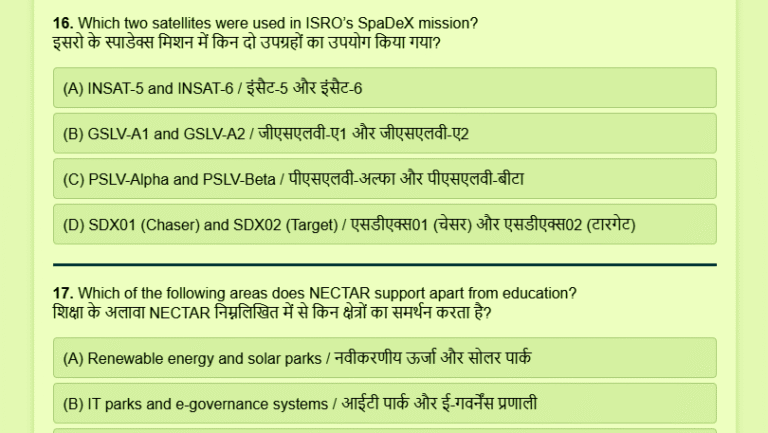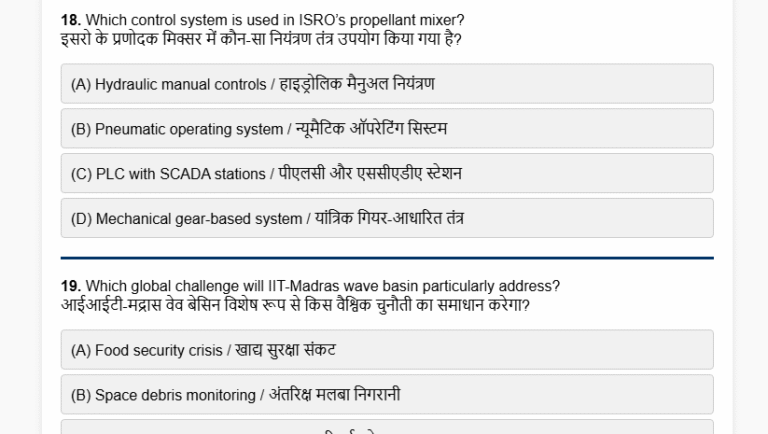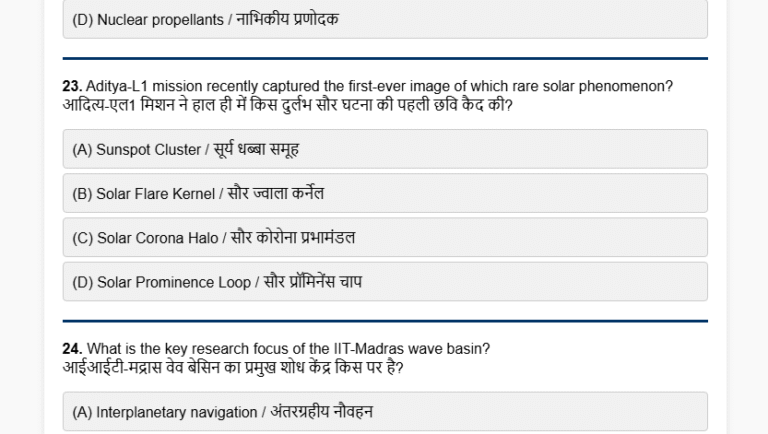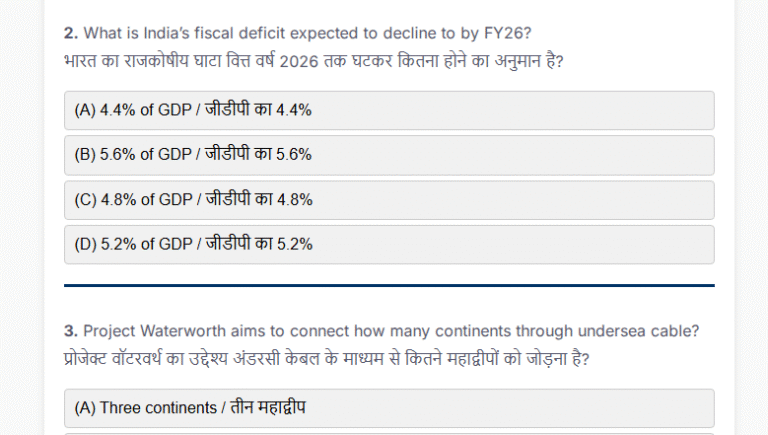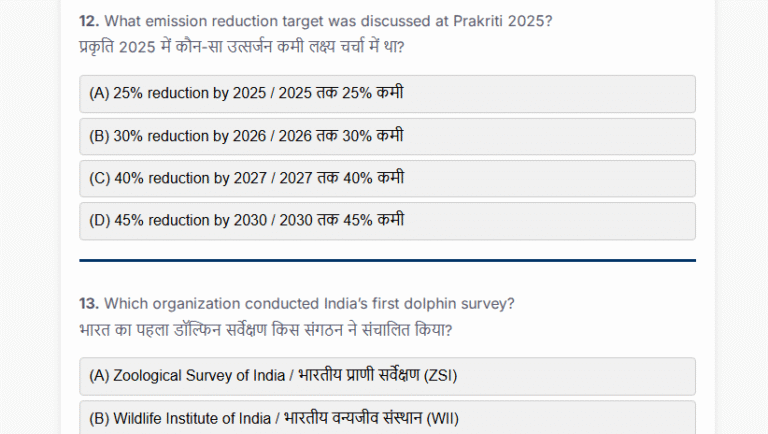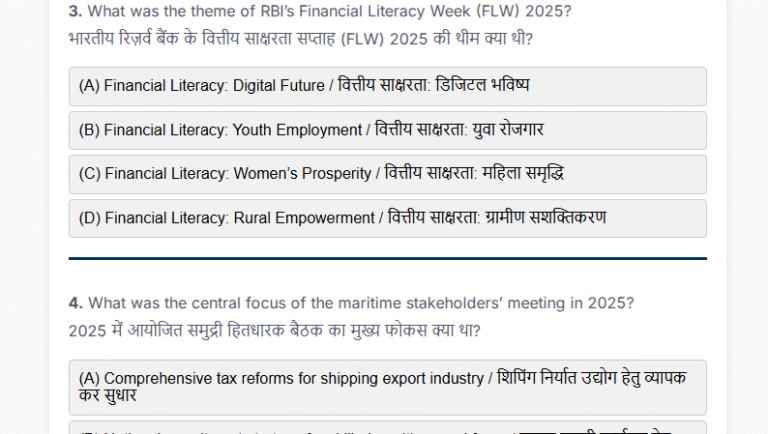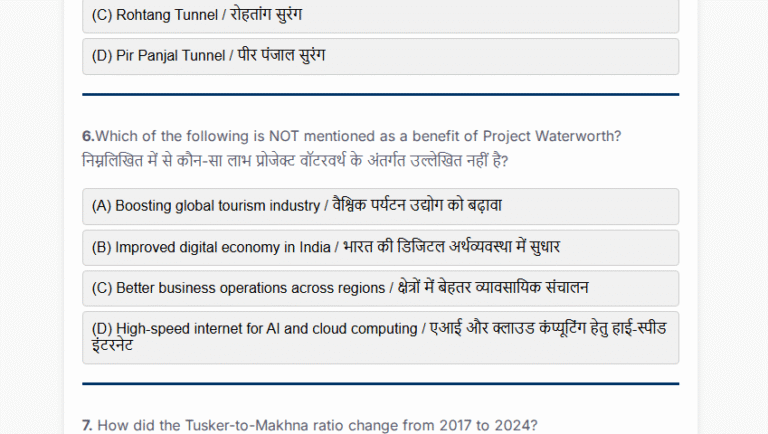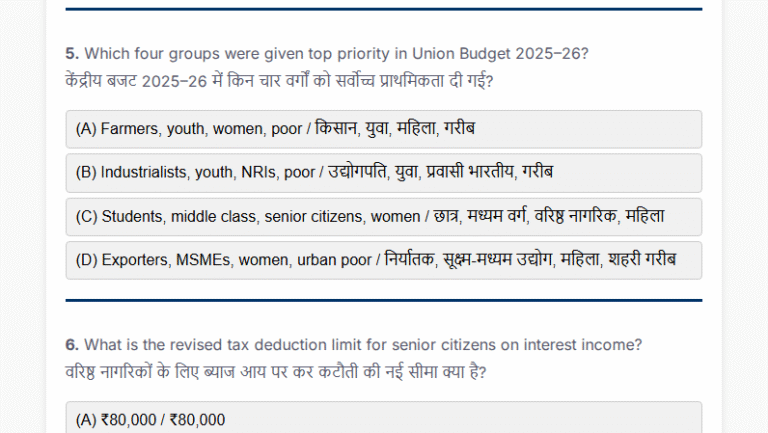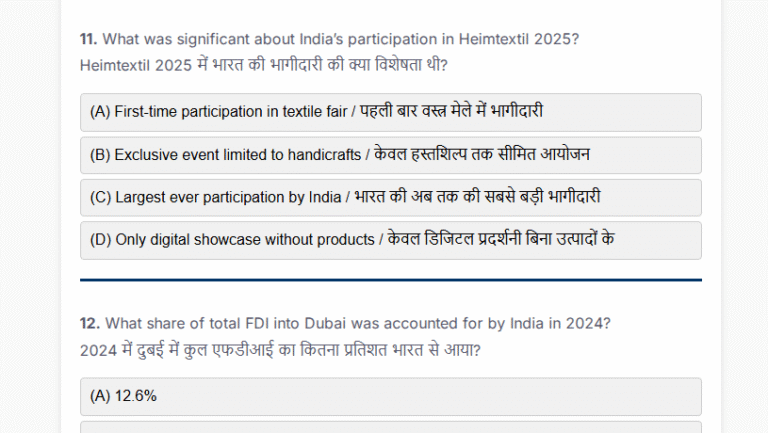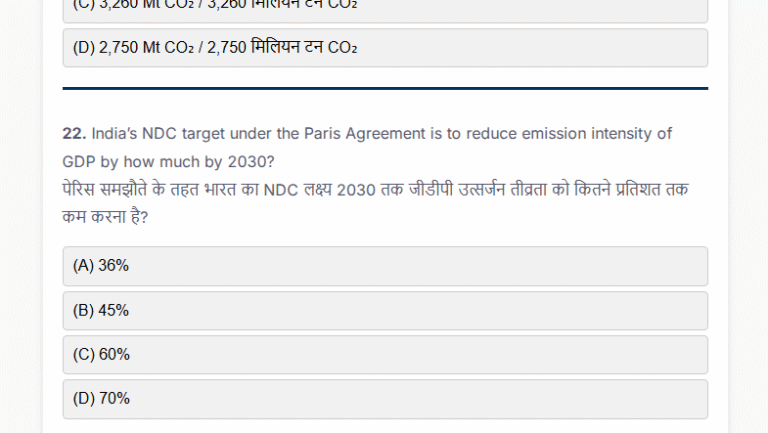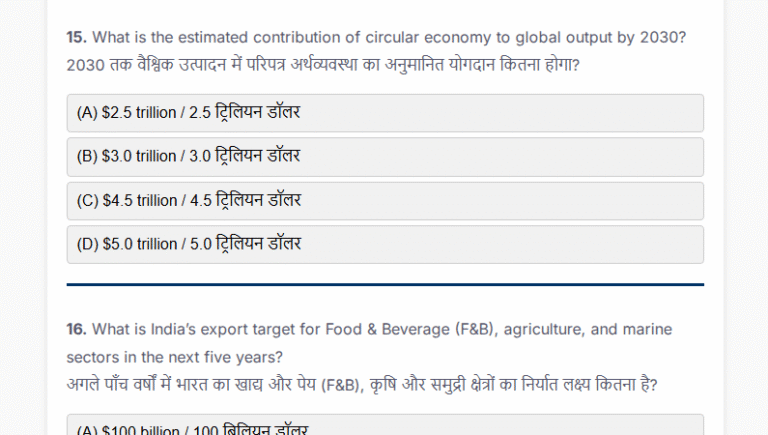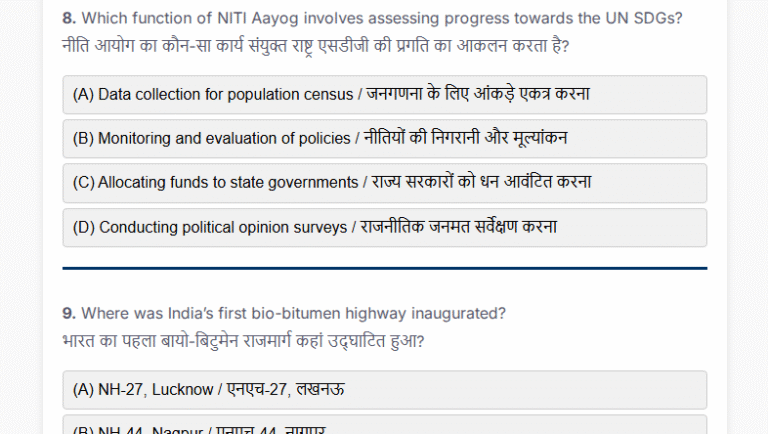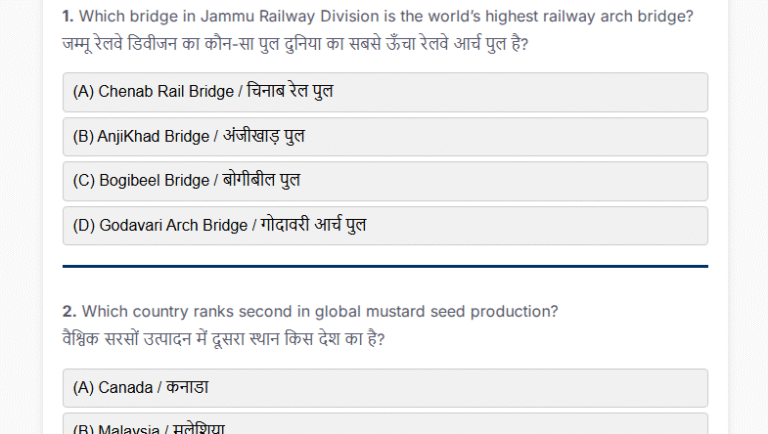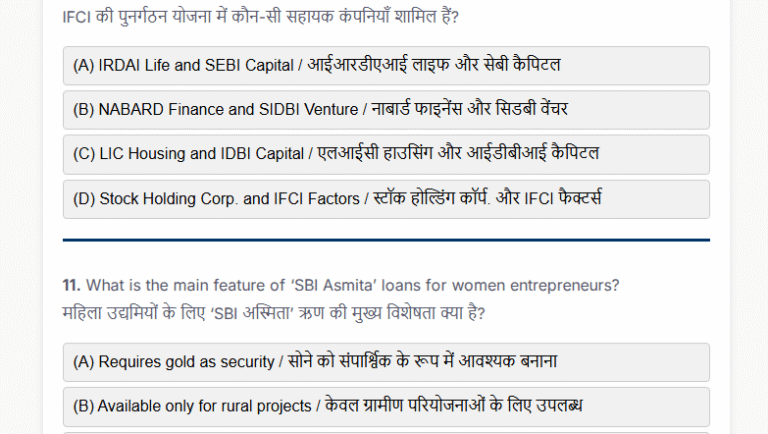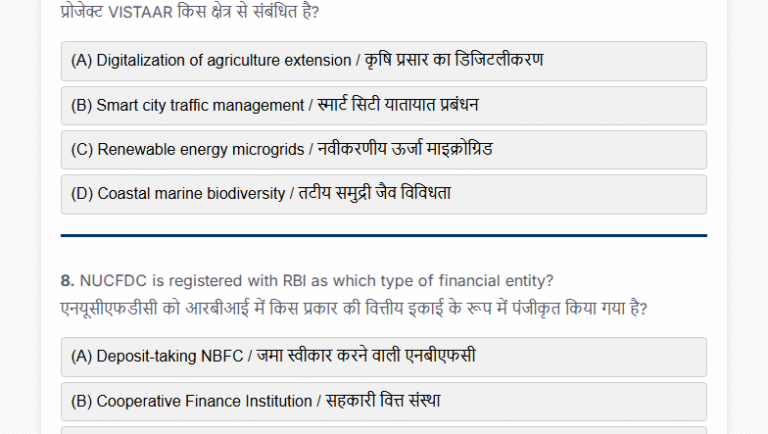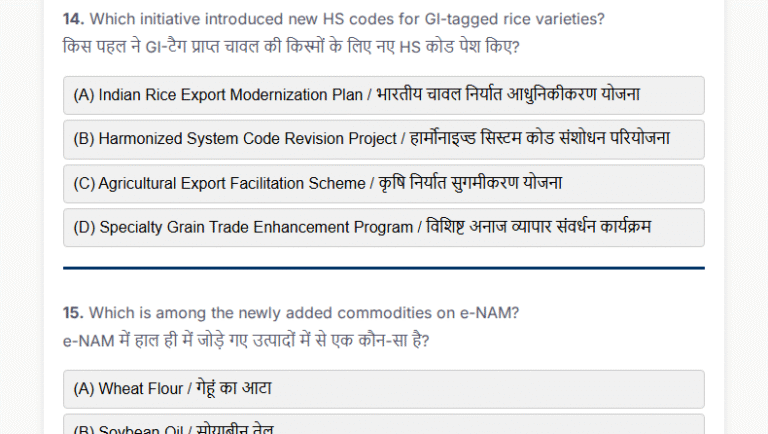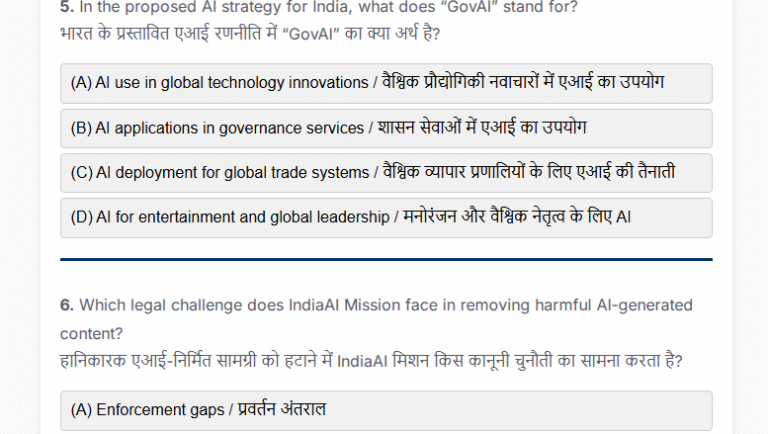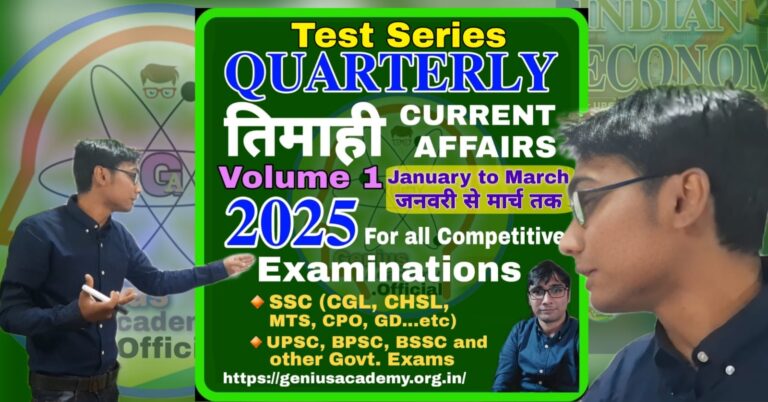Current Affairs Today MCQs (17 Nov 2024)
1. Which declaration introduced the “Partner Country Status” in BRICS?
(A) Delhi Declaration
(B) Fortaleza Declaration
(C) Kazan Declaration
(D) Yekaterinburg Declaration
The correct answer is (C) Kazan Declaration
The “Partner Country Status” was introduced in the Kazan Declaration during the 16th BRICS Summit. This status is part of the transition process in the BRICS organizational structure and aims to guide the bloc’s future expansion. Nations like Turkey, Indonesia, and Algeria were invited under this category.
2. Which country was the last to join the original BRIC grouping before its expansion to BRICS?
(A) South Africa
(B) Russia
(C) India
(D) China
The correct answer is (A) South Africa
BRIC originally included Brazil, Russia, India, and China. South Africa joined in 2010, expanding the acronym to BRICS. The grouping was conceptualized in 2001 and formalized at the BRIC Foreign Ministers’ meeting in 2006.
3. What was the primary aim of the “Ulgulan” or Great Tumult movement led by Birsa Munda?
(A) Promote missionary education
(B) Encourage industrialization in tribal areas
(C) Resist forced labor and colonial land policies
(D) Advocate for religious conversions
The correct answer is (C) Resist forced labor and colonial land policies
The Ulgulan movement, led by Birsa Munda in the Chotanagpur region, sought to resist British colonial exploitation, forced labor, and land appropriations. It mobilized Munda and Oraon tribes to fight for their rights, inspiring future tribal uprisings.
4. What is the primary aim of the PM-JANMAN package?
(A) Promote urbanization in tribal areas
(B) Enhance tribal tourism
(C) Create new tribal settlements
(D) Saturate PVTG families with entitlements and basic facilities
The correct answer is (D) Saturate PVTG families with entitlements and basic facilities
The PM-JANMAN package launched in 2023 aims to reach Particularly Vulnerable Tribal Groups (PVTGs) by ensuring access to entitlements like Aadhaar, Jan Dhan accounts, and basic amenities such as housing, drinking water, and education. It focuses on improving living standards in remote tribal areas.
5. What percentage of the global GDP does the expanded BRICS group represent?
(A) 20%
(B) 28%
(C) 35%
(D) 50%
The correct answer is (B) 28%
With its expanded membership, BRICS accounts for 28% of the global GDP. The group represents emerging economies and aims to challenge traditional Western economic dominance by promoting multilateral cooperation.
6. What was the name of the faith founded by Birsa Munda?
(A) Birsait
(B) Birsaism
(C) Mundaism
(D) Tumultism
The correct answer is (A) Birsait
Birsa Munda founded “Birsait,” a faith blending animism and indigenous beliefs. It emphasized worship of a single god, self-reliance, and resistance against British colonialism and missionary influence.
7. Which is the largest Particularly Vulnerable Tribal Group (PVTG) in India?
(A) Saura community of Odisha
(B) Baiga tribe of Madhya Pradesh
(C) Kondhs of Odisha
(D) Chenchu tribe of Andhra Pradesh
The correct answer is (A) Saura community of Odisha
The Saura community in Odisha is the largest PVTG, with a population of 535,000. PVTGs are defined by their economic backwardness, primitive traits, and geographic isolation.
8. Where was the first official BRIC summit held?
(A) New Delhi, India
(B) Brasilia, Brazil
(C) Yekaterinburg, Russia
(D) Beijing, China
The correct answer is (C) Yekaterinburg, Russia
The first official BRIC summit was hosted by Russia in Yekaterinburg in 2009. This marked the formal establishment of the grouping as a platform for emerging economies.
9. How many districts are targeted in the initial phase of the PM-JANMAN campaign?
(A) 50 districts
(B) 100 districts
(C) 150 districts
(D) 200 districts
The correct answer is (B) 100 districts
The initial phase of PM-JANMAN targets 100 districts across 18 states and the Andaman and Nicobar Islands. It focuses on reaching 15,000 PVTG habitations and addressing their basic needs.
10. What was the primary outcome of the Chotanagpur Tenancy Act, 1908?
(A) Restricted transfer of tribal land to non-tribals
(B) Promoted industrialization in tribal areas
(C) Increased missionary activities
(D) Supported colonial land appropriation
The correct answer is (A) Restricted transfer of tribal land to non-tribals
The Chotanagpur Tenancy Act was a significant outcome of the Munda revolt. It restricted the transfer of tribal land to non-tribals and recognized customary tribal rights over land, water, and forests, providing a legal safeguard for tribal communities.
11. At which BRICS Summit was the “Partner Country Status” introduced?
(A) 14th Summit
(B) 15th Summit
(C) 16th Summit
(D) 17th Summit
The correct answer is (C) 16th Summit
The “Partner Country Status” was introduced during the 16th BRICS Summit in the Kazan Declaration. This initiative is part of BRICS’ organizational evolution, aimed at facilitating future expansion and collaboration with countries like Turkey, Indonesia, and Algeria.
12. Who coined the term BRIC to describe emerging economies?
(A) Amartya Sen
(B) Jim O’Neill
(C) Joseph Stiglitz
(D) Jeffrey Sachs
The correct answer is (B) Jim O’Neill
The term BRIC was coined by British economist Jim O’Neill in 2001. It represented Brazil, Russia, India, and China as emerging economic powerhouses. South Africa joined later in 2010, making it BRICS.
13. What nickname was given to Birsa Munda by his followers?
(A) Dharti Aba
(B) Bharat Ratna
(C) Tribal Messiah
(D) Ulgulan Leader
The correct answer is (A) Dharti Aba
Birsa Munda was affectionately called “Dharti Aba,” meaning “Father of the Earth.” This title reflects his role as a protector of tribal lands and rights during his resistance against British exploitation and missionary activities.
14. How many PVTG habitations are targeted in the initial phase of PM-JANMAN?
(A) 10,000
(B) 20,000
(C) 15,000
(D) 25,000
The correct answer is (C) 15,000
The PM-JANMAN package aims to cover 15,000 PVTG habitations in its initial phase. This initiative focuses on providing essential entitlements and basic amenities to tribal groups across 18 states and the Andaman and Nicobar Islands.
15. What percentage of the global population is represented by the expanded BRICS group?
(A) 35%
(B) 40%
(C) 45%
(D)50%
The correct answer is (C) 45%
With its expanded membership, BRICS now represents 45% of the global population, highlighting its significant demographic and geopolitical influence on the global stage.
16. What key legislative outcome resulted from the Munda revolt?
(A) Chotanagpur Tenancy Act
(B) Santhal Tenancy Act
(C) Forest Rights Act
(D) Tribal Welfare Act
The correct answer is (A) Chotanagpur Tenancy Act
The Chotanagpur Tenancy Act of 1908 was a direct result of Birsa Munda’s Ulgulan (Great Tumult) movement. It provided legal protection for tribal land rights, restricting non-tribals from acquiring tribal lands.
17. Which of the following is NOT a characteristic used to identify PVTGs?
(A) Pre-agricultural level of technology
(B) Economic backwardness
(C) Declining population
(D) High literacy levels
The correct answer is (D) High literacy levels
PVTGs are identified based on characteristics like low literacy, economic backwardness, reliance on primitive technology, and a declining or stagnant population. High literacy is not a defining trait of PVTGs.
18. Where is the headquarters of BRICS located?
(A) Moscow, Russia
(B) Shanghai, China
(C) New Delhi, India
(D) Johannesburg, South Africa
The correct answer is (B) Shanghai, China
The BRICS headquarters is located in Shanghai, China. This central location supports the grouping’s coordination and facilitates discussions on economic and developmental strategies.
19. What specific challenge does PM-JANMAN address concerning mobile networks in tribal areas?
(A) Urban connectivity
(B) Mobile banking
(C) Extending mobile networks to remote tribal villages
(D) Development of 5G networks
The correct answer is (C) Extending mobile networks to remote tribal villages
PM-JANMAN aims to bring mobile networks to distant tribal villages to improve connectivity and enable access to government schemes and digital resources, addressing the issue of digital exclusion.
20. On which day is Birsa Munda Jayanti celebrated?
(A) 1st November
(B) 15th November
(C) 20th November
(D) 25th November
The correct answer is (B) 15th November
Birsa Munda Jayanti is celebrated on 15th November, marking the birth anniversary of the tribal leader. In 2021, it was declared ‘Janjatiya Gaurav Divas’ to honor his legacy.
_
Set 20 Quarterly CA 2025 Jan to March IMPORTANT INSTRUCTIONS This test consists of 25 questions.At…
Set 19 Quarterly CA 2025 Jan to March IMPORTANT INSTRUCTIONS This test consists of 25 questions.At…
Set 18 Quarterly CA 2025 Jan to March IMPORTANT INSTRUCTIONS This test consists of 25 questions.At…
Set 17 Quarterly CA 2025 Jan to March IMPORTANT INSTRUCTIONS This test consists of 25 questions.At…
Set 16 Quarterly CA 2025 Jan to March IMPORTANT INSTRUCTIONS This test consists of 25 questions.At…
Set 15 Quarterly CA 2025 Jan to March IMPORTANT INSTRUCTIONS This test consists of 25 questions.At…
Set 14 Quarterly CA 2025 Jan to March IMPORTANT INSTRUCTIONS This test consists of 25 questions.At…
Set 13 Quarterly CA 2025 Jan to March IMPORTANT INSTRUCTIONS This test consists of 25 questions.At…
Set 12 Quarterly CA 2025 Jan to March IMPORTANT INSTRUCTIONS This test consists of 25 questions.At…
Set 11 Quarterly CA 2025 Jan to March IMPORTANT INSTRUCTIONS This test consists of 25 questions.At…
Set 10 Quarterly CA 2025 Jan to March IMPORTANT INSTRUCTIONS This test consists of 25 questions.At…
Set 9 Quarterly CA 2025 Jan to March IMPORTANT INSTRUCTIONS This test consists of 25 questions.At…
Set 8 Quarterly CA 2025 Jan to March IMPORTANT INSTRUCTIONS This test consists of 25 questions.At…
Set 7 Quarterly CA 2025 Jan to March IMPORTANT INSTRUCTIONS This test consists of 25 questions.At…
Set 6 Quarterly CA 2025 Jan to March IMPORTANT INSTRUCTIONS This test consists of 25 questions.At…
Set 5 Quarterly CA 2025 Jan to March IMPORTANT INSTRUCTIONS This test consists of 25 questions.At…
Set 4 Quarterly CA 2025 Jan to March IMPORTANT INSTRUCTIONS This test consists of 25 questions.At…
Set 2 Quarterly CA 2025 Jan to March IMPORTANT INSTRUCTIONS This test consists of 25 questions.At…
Set 3 Quarterly CA 2025 Jan to March IMPORTANT INSTRUCTIONS This test consists of 25 questions.At…
Test Series of 1st Quarterly Current Affairs 2025 प्रथम त्रैमासिक करेंट अफेयर्स 2025 की टेस्ट सीरीज़…
Current Affairs Today MCQs (26 Nov 2024) 1. What is the primary purpose of the Rejang Dewa dance in…
Current Affairs Today MCQs (25 Nov 2024) 1. What feature distinguishes African penguins from other…
Current Affairs Today MCQs (24 Nov 2024) 1. Which of the following is a distinctive feature of…
Current Affairs Today MCQs (23 Nov 2024) 1. What is the target adaptation finance commitment for the…
Current Affairs Today MCQs (22 Nov 2024) 1. How many youth are targeted for internships under the PM…
Current Affairs Today MCQs (21 Nov 2024) 1. Which is the funding ratio for PM-JAY between the Centre…
Current Affairs Today MCQs (20 Nov 2024) 1. Who is eligible for the Ayushman Vay Vandana Card? (A)…
Current Affairs Today MCQs (5 Nov 2024) 1. What conditions contribute to the formation of the DANA…
Current Affairs Today MCQs (4 Nov 2024) 1. What is the primary function of Israel’s Iron Beam…
Current Affairs Today MCQs (3 Nov 2024) 1. To whom was the Balfour Declaration addressed? (A) David…


